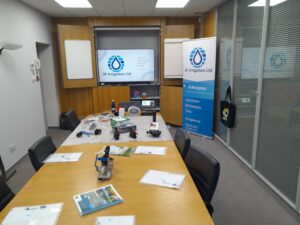How to become an irrigation technician? (Part two)
Related Articles
I receive messages on social media, in person while on site, and within my training sessions asking this question. I feel the industry is waking up to the need for more available training and knowledge around irrigation.
You will need to know the financial worth of irrigation products (see the April 2023 issue of GreenKeeping).
A key area to learn is also fault finding. Here are some key tips:
1. Check for human error, is the station on from the controller with a run time, auto position out on the course, pipe work isolated for an unknown issue? Go back to the basics before looking to replace any parts or spending time digging. What could someone have turned off to create the fault?
2. All copper should be shiny! Wiring joints that are darkened, muddy, wet and just simply not shiny copper wont conduct in an efficient way. Scrap the copper to create a shiny surface. Less voltage passing equals more issues. If you see it, then redo it!
3. Ohms your coils with a meter. I personally say ‘listen to your coils’ as the Ohms logo reminds me of a pair of headphones, Silly I know but that’s how I learnt to remember it. Simply keep a brand-new coil of the same type in your toolbox to remind yourself what reading they should show. Test the new toolbox coil, then test the coil in the ground once unwired from any decoder.
4. Solenoid valves that let water pass – the normal scenario is when the lowest sprinkler away from the valve lets water pass, even when the station isn’t running, then there is a fault. A simple test is to listen to the solenoid valve when it’s not running, putting your ear as close as you can. If you hear a hissing noise, then the valve is letting water pass. The valve then requires a service to help diagnose the problem.
5. Slow solenoid operation. Nine out of ten times a solenoid valve will have the flow control setting and this is very likely opened fully. If you see the solenoid taking a while to close once turned off you can help reduce this closing time by adjusting the flow control to suit. Google the brand for the flow control location, normally in the middle of the solenoid, and operated by hand.
First run the solenoid for one minute, this will allow for the operating pressure to be met and the pumps to kick in. Then while it’s running, turn down the flow control, ‘rightly tightee’, until you hear a difference in the solenoid and see the sprinklers slightly change. At that point turn ‘lefty lucy’ just a little.
Then, when you turn off the solenoid you will find it will close faster, reducing water, heavy water drops and creating more pressure for the next station in your automatic cycle. Older systems can use the slow shutting to their advantage if the irrigation system suffers from water hammer.
6. Leaks. As mentioned in number one, consider human error when searching for a leak such as recent works undertaken or other works in the area that may have affected the irrigation such as tree works, construction and the dreaded trencher!
7. Valve in head sprinklers. A bit like the topic of solenoids I feel I could write a page solely on each topic and I will in the future. As this article is about key tips for faulting, I will keep it simple:
Check the sprinkler is in auto, if you can’t see it clearly on the sprinkler, look for another one or a new stock sprinkler to see where the selector key should be facing.
If the sprinkler doesn’t operate from the controller the fastest and first thing to check is the wiring; rewire the connections and test.
John Kidson will continue his irrigation technician guide over the next few issues. Message him @JKIrrigation on all socials
Part one can be found here: www.greenkeepingeu.com/how-do-you-become-an-irrigation-technician




























